New Air-conditioning
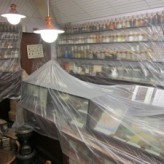
.
During the week 10-14 December new air-conditioning machinery and associated pipework are being installed in the Museum and in the meeting/exhibition room next door.
As a precaution against the dust that could have accumulated in the roof space being released when suspended ceiling tiles are removed, as much as practical of...
Read MoreMuseum Publication: The Christopher Pharmacy

The first of Bradford on Avon Museum’s booklets has now been published, in conjunction with publishers Bed and Bolster.
The all-colour booklet details the history of the chemist shop that now forms the centrepiece of the Museum and gives an idea of how its business was carried out.
The booklet sells at £2 and is available in the Museum and from the Tourist Information...
Read MoreGlass bottles: Tincture Rounds
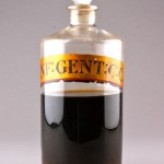
.
The Christopher Pharmacy at Bradford on Avon Museum, Wiltshire
.
Tincture rounds are cylindrical glass bottles that are designed to hold the liquid tinctures the chemist extracted from plant material. They have narrow necks with ground glass stoppers. Tinctures were chemical extracted by...
Read MoreGlass bottles: Ether Rounds
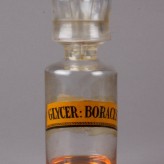
.
The Christopher Pharmacy at Bradford on Avon Museum, Wiltshire
.
Ether rounds are cylindrical bottles that are designed to hold volatile liquids that are likely to blow their stoppers out. They may have a cover of glass, like this one, or of metal to make sure the...
Read MoreCosmetics and Perfumes
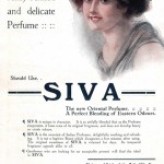
Richard Christopher spent some time in Singapore after he qualified as a pharmacist, returning via Ceylon (Sri Lanka) and India. When he came to Bradford on Avon in 1908 to work the shop he immediately started to develop a range of perfumes, soaps and cosmetics based on the scents and flavours he discovered in the East.
Click on the thumbnail pictures for a bigger...
Read MoreMedicine Bottles
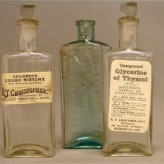
.
Richard Christopher supplied the liquid medicines to his customers in glass bottles, often with dose graduations, usually in teaspoons, on the side. He had drawers full of printed labels for all sorts of medicines and bearing his name.
Click on the thumbnail pictures for a bigger...
Read MoreBranded Medicines
.
The Christopher chemist shop
Bradford on Avon Museum, Wiltshire
.
The chemist shop, specially late in its life, always sold medicines made by others. Often in the early days these proprietary medicines were of the cure-all sort or tonics. By the late 20th century increasing...
Read MoreNon-medical stock
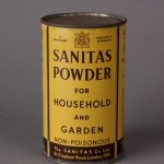
Chemist shops, as the name implies, dealt in all sorts of chemicals and products that had a origin relating to chemical processes- hence photography, household cleaners, soap, insecticides and even alcoholic drinks.
Click on the thumbnail pictures for a bigger view.
Many dry products came in cardboard cylinders with tinned steel tops and bases like this...
Read MoreVeterinary medicines and equipment
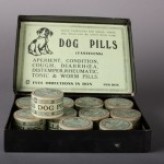
As well as supplying medicines for people, the chemist made and sold medicines for domestic and farm animals.
.
Click on the thumbnail pictures for a bigger view.
.
R.T. Christopher sold medicines to the public for their pets. These...
Read MorePoison Bottles
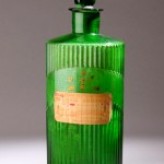
Bottles for containing poisonous chemical were usually distinguished from others by colour, usually blue or green, and by touch -with ridges and different shapes.
Click on the thumbnail pictures for a bigger view.
.
A poison round bottle with both colour and touch differences. It has...
Read MoreWeights and Measures
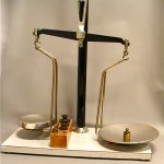
The pharmacist spent a good deal of time in measuring quantities of chemicals by weight and by volume. Until the late 20th century pharmacists were very conservative in their use of old-fashioned systems of measurement. As well as familiar pounds and ounces, pints and fluid ounces they used less familiar units, passed on from the old days of apothecaries, for measuring...
Read MorePestles and Mortars
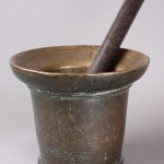
.
Pestles and mortars were important pieces of apparatus in the old-time chemist shop and are used as an international sign for a pharmacist. They were used to bruise, crush, grind and mix chemicals and the raw materials from which medicines were derived. They come in all sorts of sizes depending on the amount being dealt...
Read MoreCarboys
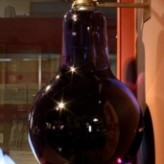
A carboy is a large glass vessel for containing a big quantity of liquid.
.
Four decorative carboys were displayed in the chemist shop windows and are again in the reconstruction in the Museum. Of a distinctive shape, they form part of the identification of a chemist shop; even today small versions can be seen at the...
Read MoreSyringes, enemas and nasal douches
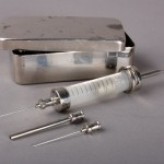
Click on the thumbnail pictures for a bigger view.
Hypodermic syringe kit and its carrying box. These are designed to deliver a chemical or vaccine into muscle or blood vessel. The literal meaning of hypodermic is ‘under the skin’.
.
.
Read More
Glass Bottles: Winchesters
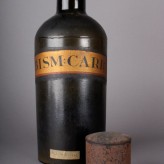
.
Winchesters are bottles of a gallon capacity, used for storage or for those chemicals of which larger quantities than the shop round bottles were needed.
This is one of a set of large bottles from the Christopher shop. They were made by Henry Ricketts in Redcliffe, Bristol to his 1825 patent for making...
Read MoreThe Museum Collection: Photography
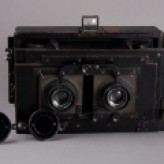
One of the main activities of a chemist shop was the supply of films and chemicals and the processing of films for members of the public. Richard Christopher was himself a keen photographer.
Click on the thumbnail pictures for a bigger view
One of Richard Christopher’s own cameras was this Goertz stereoscopic camera (left). It...
Read MoreThe Museum Collection: Prescription books
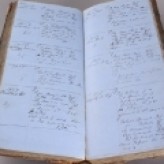
.
The Christopher chemist shop
Bradford on Avon Museum, Wiltshire
.
The Museum possesses a complete run of prescription books for its chemist shop, from the day it opened in 1863 until the day it closed in 1986.
Read More
Glass bottles: syrup rounds
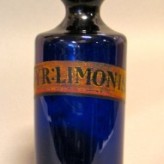
The syrup bottles in Bradford on Avon Museum’s pharmacy are of mouth-blown blue (cobalt) glass with flared necks to give easy pouring and loose-fitting stoppers that can be opened even if the syrup has stuck them to the opening. Each has a label with the contents in abbreviated Latin. Most of these mixtures were to be used in treating coughs or were ingredients of...
Read MoreGlass bottles: powder rounds
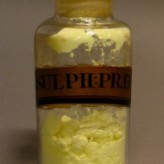
. The Christopher Pharmacy at Bradford on Avon Museum, Wiltshire .
Powder rounds are cylindrical bottles which have a wide mouth so that a spoon could be used to scoop out amounts of the contents. The bottles are usually mouth-blown, so have the pontil mark on the base where a rod was fixed so that the...
Read MoreThe Christopher Pharmacy
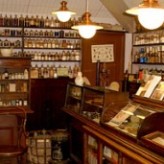
The shop is the reason for the Museum’s existence. When Miss Christopher was to retire in 1986, the shop would close for good and all its antique features would be sold off and dispersed, or consigned to a skip. With help from a grant from the Science Museum the newly-formed Museum Society purchased the furniture and old contents. A recreation of the shop was built...
Read More
